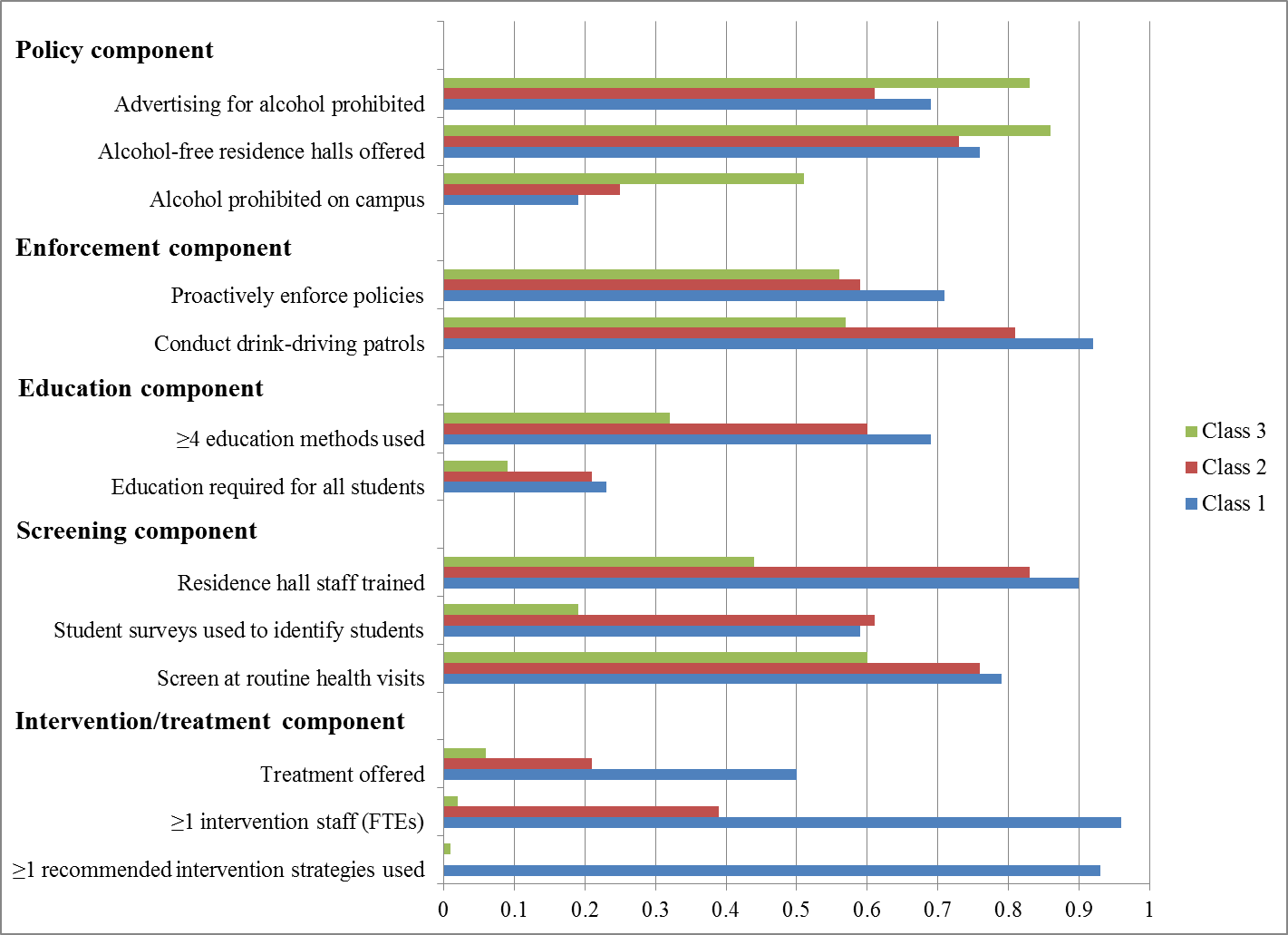The DRAM, Vol. 9(11) – Assessing alcohol abuse prevention systems at US colleges
The risks to college students who drink at heavy or problematic levels are well-known (e.g., unintentional injuries, academic problems; Hingson, Zha, & Weitzman, 2009). To combat these problems, college administrators and health prevention specialists have implemented strategies that target both individuals and their environment to reduce high-risk drinking. This week’s DRAM reviews a study that assessed the current status of systems to prevent alcohol abuse at U.S. colleges (Toomey et al., 2013).
Methods
- The researchers identified 1,572 accredited 4-year residential colleges and stratified the list according to college size (small: <2,500 students or large: >2,500 students) and funding source (public vs. private). Then, they randomly selected schools from within each stratum. The final selection was weighted to include schools in proportion to overall student enrollment: 100 small private, 100 small public, 101 large private, and 268 large public colleges.
- Researchers looked to previous research (Nelson, Toomey, Lenk, Erickson, & Winters, 2010) and recommendations from government agencies (e.g., National Institute on Alcohol Abuse and Alcoholism, 2007) to identify variables along which to categorize colleges. They tailored surveys such that different campus officials described variables with which they were most familiar.
- Administrators described general alcohol policies (e.g., whether there was a prohibition on alcohol advertising, whether there was an alcohol-free residence option) and education (e.g., whether the college required alcohol education).
- Campus enforcement officials described alcohol enforcement practices (e.g., whether they proactively enforce alcohol policies).
- Healthcare officials described alcohol-related screening efforts (e.g., screening for alcohol misuse during routine health visits) and intervention (i.e. use of 1 or more recommended intervention strategies, presence of 1 or more full-time intervention staff) / and treatment approaches.
- Campus officials completed the surveys via email or by telephone, and response rates were 61% for campus enforcement officials and 62% for both administrators and healthcare officials.
- The researchers used latent class analyses to identify classes of colleges that differ according to these 5 component areas (i.e., general alcohol policies, education, enforcement, screening, and intervention/treatment).
Results
As the Figure shows, the research team identified three distinct classes of colleges:
- 34% of colleges fell into Class 1. Class 1 schools had a high probability for using one general alcohol policy strategy and moderate probability for a second general alcohol policy. They had a high probability of using four or more alcohol education strategies. Class 1 schools also had a high probability of instituting both intervention approaches and for having a high probability of proactively enforcing its policies. They had a high probability for using two of the three screening components.
- 35% of colleges were identified as Class 2. These schools were similar to Class 1 in their probability of instituting general alcohol policies and adopting education and screening strategies. However, compared to Class 1, they had lower probability of using two enforcement strategies and had very low probability of using intervention strategies.
- 30% of colleges were identified as Class 3. These schools were most dissimilar to the other classes. Although they had the highest probabilities of implementing multiple general alcohol policies strategies, they had very weak probabilities in the other components with the exception of having moderate probabilities for enforcement strategies and screening at routine health visits.
Figure. Probabilities of using specific alcohol-abuse prevention strategies by Class (modified from Toomey et al., 2013). Click image to enlarge.
Limitations
- This study relies on self-report data from school officials. It is possible that administrators who were unsure about certain strategies reported being more or less compliant than they actually were.
- Researchers had more measures than could be included in a single latent class analysis. To address this, they ran a set of analyses for each component and reduced the number of measures to include only those that helped differentiate the classes. It is possible important characteristics were left out of the final analysis.
- This study excluded from analyses the broader programs and policies in place at the local and state level to combat high-risk drinking that might help to distinguish the classes.
Conclusions
One-third of the colleges surveyed had taken what these researchers considered to be comprehensive approach to addressing student alcohol use. However, none of the colleges had implemented all of the strategies and many failed to implement complementary strategies such as screening plus intervention and treatment. This was particularly true of Class 2 colleges. Future studies should explore how colleges choose strategies to implement, the efficacy of different combinations of strategies, and what barriers exist to further implementation, as well as how these classes are related to the prevalence of alcohol misuse on campus.
-John Kleschinsky
What do you think? Please use the comment link below to provide feedback on this article.
References
Hingson, R. W., Zha, W., & Weitzman, E. R. (2009). Magnitude of and trends in alcohol-related mortality and morbidity among U.S. college students ages 18-24, 1998-2005. J Stud Alcohol Drugs Suppl(16), 12-20.
National Institute on Alcohol Abuse and Alcoholism. (2007). What Colleges Need to Know Now: An Update on College Drinking Research. Washington, DC: National Institutes of Health.
Nelson, T. F., Toomey, T. L., Lenk, K. M., Erickson, D. J., & Winters, K. C. (2010). Implementation of NIAAA College Drinking Task Force recommendations: how are colleges doing 6 years later? Alcohol Clin Exp Res, 34(10), 1687-1693. doi: 10.1111/j.1530-0277.2010.01268.x
Toomey, Traci L., Nelson, Toben F., Winters, Ken C., Miazga, Mark J., Lenk, KKathleen M., & Erickson, Darin J. (2013). Characterizing college systems for addressing student alcohol use: latent class analysis of U.S. Four-year colleges. Journal of Studies on Alcohol and Drugs, 74(5), 777-786.
